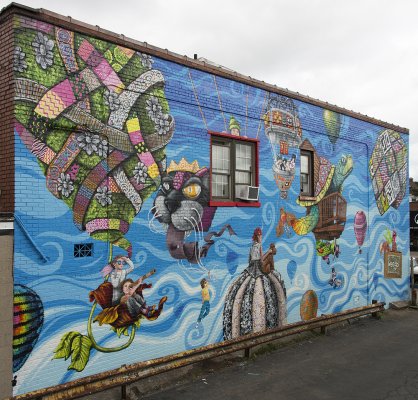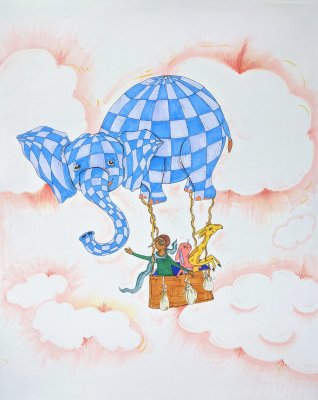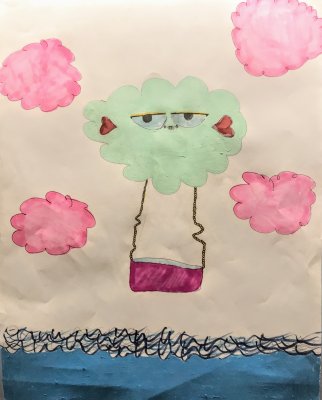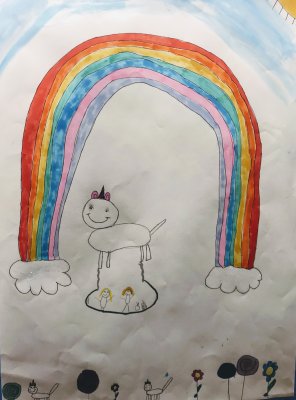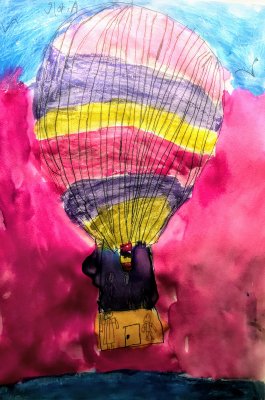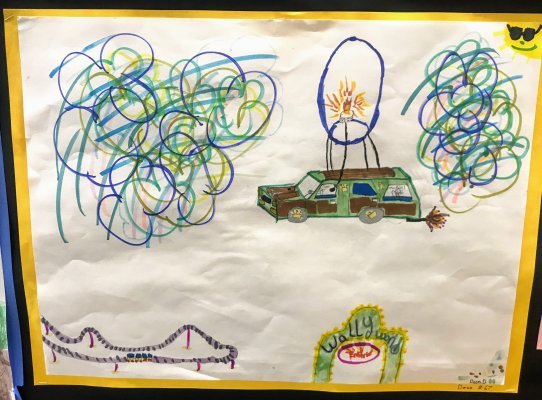Materials
Artmaking
- Drawing paper
- Black pen or marker
- Coloring tools (pens, markers, colored pencils, crayons, etc.)
- Optional: Paint and painting supplies (brush, cup for water)
Guided Play
- A big box or a container (like a plastic tote)
- Scarf and sunglasses (or goggles)
- Paper
- Pencil/pen
Vocabulary
Mural: a work of art (usually a painting) created directly on a wall
Nostalgia: remembering fondly (wistful affection) of the past, typically for a period or place with happy memories
Whimsy: behavior that is unusual, playful, and unpredictable, rather than having any serious reason or purpose behind it
Discussion and Video
Begin by using the Teaching Tips and Tools for Discussion. Ask students to notice all the different elements they can find in this mural. An example of how to bring in information about the artist from something your student observed: If they mentioned that the image on the top right looks like a Rubik’s Cube, or various games along those lines, you can bring up that the mural is celebrating nostalgia for the artists’ childhoods in the late 1980s/early 1990s.
Next, watch the Albright-Knox's video about the artists making the mural, below.
Lead a discussion about what students have observed, with questions such as: What do you think about two artists working together to make one work of art? Is that something you would want to try to do or would you prefer to make art by yourself? Why or why not? Is it OK for art to sometimes not be serious? When you make art, do you like making art that is serious, funny, and/or weird?
Artmaking Activity
Overview: In this activity, students will draw a hot air balloon–like object from their imagination. Using color, students will be encouraged to add whimsical patterns and designs to spur fun, silliness, and play.
1. First, brainstorm with your students some of their favorite games, sports, or toys. Write them down in a list. Students should draw any patterns or designs to decorate their basket. Once their basket is ready for its balloon, have them choose one or two items from the list.
2. Using coloring materials, students should draw those items as their balloon. Encourage them to get creative, and show how their object can be stretched, enlarged, or shrunken. Remind them to make it look like a hot air balloon that they would want to go for a ride and travel around the world.
3. Lastly, students should either paint or color in their backgrounds. Ask: You are way up in the sky—what would be around you? Pink clouds? Green birds? A colorful kite?
An alternative for this activity is for the student to make the art along with another family member to get a feel for what it was like for Chuck and Matt. They can take time to discuss what the top of their balloon will look like—what designs will they use? What colors should they use to represent both of them? They can collaborate on the drawing and coloring, sharing different aspects of the artmaking.
